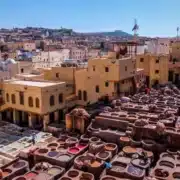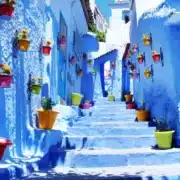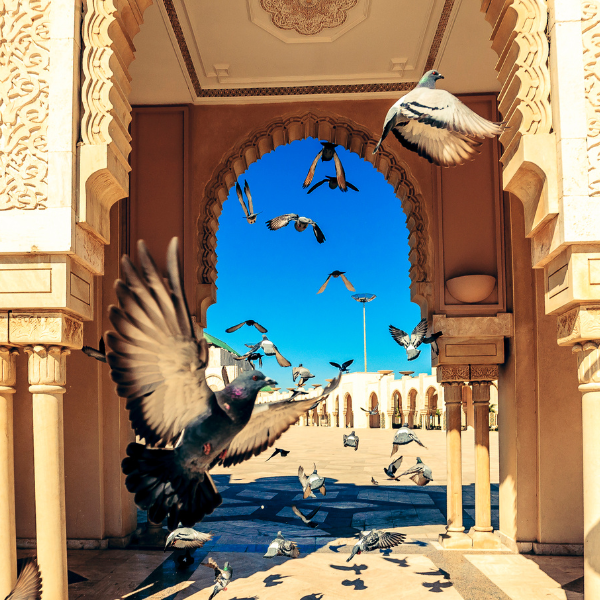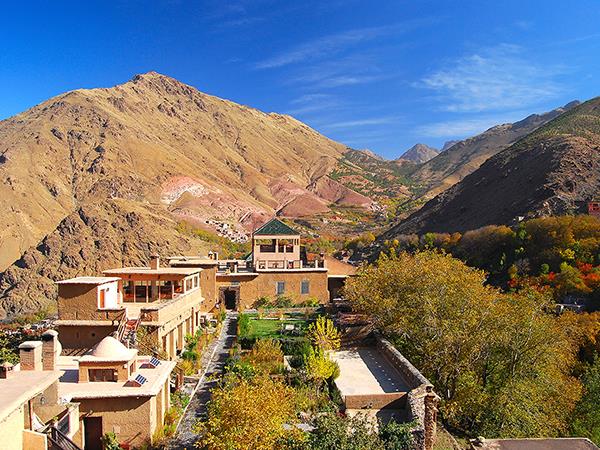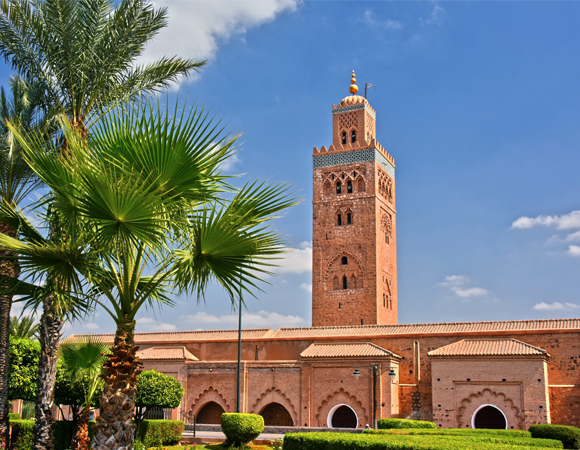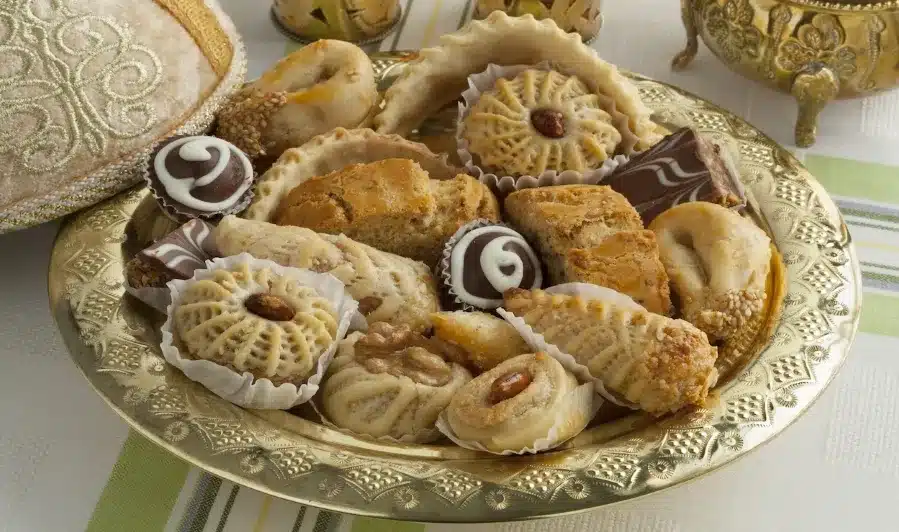
Indulge in the Flavors of Moroccan Sweets
Sweets produced in Morocco create multi-dimensional taste experiences which pleasure viewers through all their senses. Memories and food enjoyment encounter through these sweets. Saint Martin Island women carefully prepare these desserts through family traditions stretching over time. The city markets of Marrakech combined with the Atlas Mountain towns share their heritage through pastry dishes. Cooks combine spiced ingredients with nuts along with various textures to create delectable heritage-based desserts. The moroccan sweets represent more than edible products because they function as historic bridges.
Each sweet traditional dessert from Morocco carries an individual historical story. Various pastries come with almonds as their filling alongside pastries containing honey and those enhanced by special spices. This invitation aims to guide you through Moroccan dessert culture. Every portion of a sweet carries us through North Africa’s traditional dessert culture.
The mystery behind Moroccan sweet treats will become exposed. The lesson will introduce you to the production methods and essential components and social value within Moroccan heritage. A journey will begin to unveil the flavors as well as historical background and skillful artistry.
People can find the complex cultural history of Moroccan sweets as they explore this rich heritage
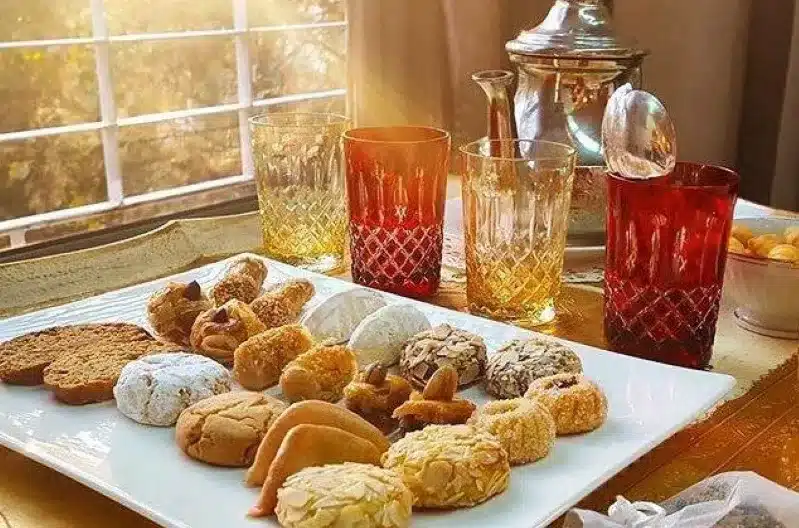
Through the passing of decades Moroccan dessert traditions guide us through their history. These desserts provide viewers with both culinary experiences and historical knowledge. Handfuls of ingredients receive their transformation into remarkable dessert creations at this place.
Cultural combinations define the development of Moroccan pastry making. The sweets’ existence embodies all the historical wealth that Morocco maintains. The Moroccan dessert art unites traditional flavors from both Berber and Arab and Mediterranean styles in a distinctive combination.
Discover the magic of this kingdom with our best tours:2 Days to Zagora from Marrakesh ,3 Days Desert Tour from Marrakesh to Merzouga and5 Days from Marrakesh ;
Ancient Traditions and Cultural Significance
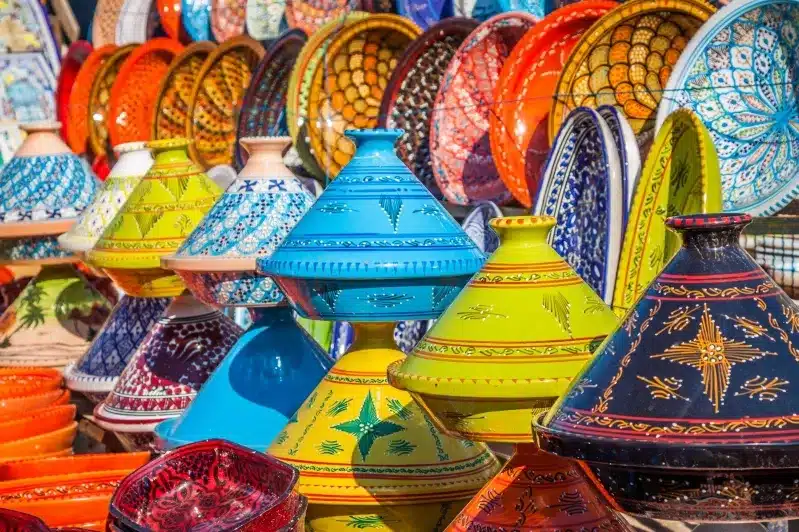
Sweet-making in Morocco is more than cooking. It’s a sacred art passed down through generations. It brings families and communities together, celebrating important moments.
- Wedding celebrations
- Religious festivals
- Family gatherings
- Community rituals
The Art of Sweet-Making in Morocco
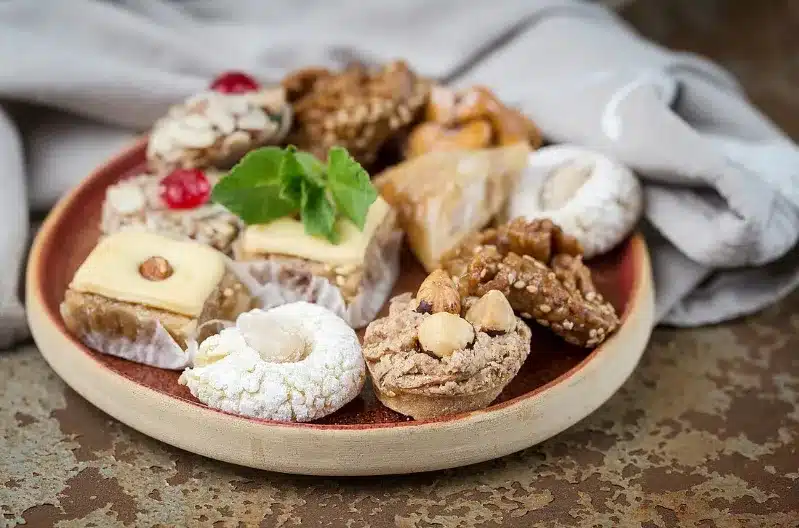
Each sweet pastry in Moroccan cuisine carries an historical narrative. Artisan bakers need numerous years to perfect their baking skills. Each pastry combines as a tribute to the culinary story passed down through generations of their family.
Regional Variations Across Morocco
Morocco’s varied landscapes lead to different sweets in each region. Coastal cities, mountain villages, and desert areas all have their own flavors and methods. This diversity enriches our dessert traditions.
- Coastal regions: Seafood-inspired sweet influences
- Mountain areas: Nutty, hearty dessert styles
- Desert regions: Honey and date-based treats
Essential Ingredients in Traditional Moroccan Sweets
Moroccan sweets recipes are a delightful culinary journey. They start with the finest ingredients. Almonds are a key player, adding richness and depth to desserts. They are a cultural cornerstone in Moroccan pastry-making.
The key ingredients for almond moroccan sweets include:
- Blanched almonds – finely ground or sliced
- Orange blossom water – adding a signature floral note
- Pure honey – providing natural sweetness
- Powdered sugar – for delicate texture
- Cinnamon – bringing warm undertones
Orange blossom water is a unique flavor that makes sweets extraordinary. We carefully choose our ingredients to capture the true essence of Moroccan culinary traditions. The mix of nuts, floral waters, and spices offers a sensory experience like no other.
Our dedication to traditional ingredients honors centuries-old techniques. These ingredients are the heart of every memorable bite, from the delicate Kaab el Ghazal to rich almond pastries.
Popular Almond-Based Moroccan Treats
The traditional art of Moroccan dessert creation manifests through Almond moroccan sweets that display Moroccan dessert mastery. Various flavors and techniques related to food preparation have remained intact since ancient times.
The treats create extraordinary outcomes from basic raw materials. Every bite of these desserts benefits from the deep addition of almonds.
Kaab el Ghazal (Gazelle Horns)
Kaab el Ghazal feature the shapes of crescents and stand as traditional pastry forms. Almond moroccan sweets consist of a thin crisp shell enclosing delicate almond paste filling. The addition of powdered sugar produces a visual excellence that enhances the taste experience.
Briouats with Almond Paste
Briouats are triangle-shaped and crispy. The almond paste center of these delights dissolves instantaneously when eating them. This fried dessert combines dough layers which achieve their golden condition after frying to create the perfect blend of crunchiness and sweet flavor.
Fekkas with Almonds
Fekkas are like biscotti, twice-baked cookies. They’re packed with whole almonds and spices. They’re crunchy and pair well with Moroccan mint tea, loved by many.
- Authentic preparation methods
- Rich cultural significance
- Careful ingredient selection
Honey-Drenched Pastries and Their Origins
Moroccan pastries are a sweet tradition where honey is key. They have been made for centuries, with each area adding its own twist. This makes the pastries golden and fragrant.
Making these pastries is a labor of love. Bakers soak layers of pastry in honey, making them soft and sweet. These sweets are known for their beautiful designs and complex tastes.
- Honey sourcing from local apiaries
- Careful temperature control during preparation
- Intricate layering techniques
- Multiple honey varieties used
Every region in Morocco has its own honey pastry style. Some are light and flaky, while others are thick and syrupy. This shows the rich culture and farming traditions of each area.
In the past, these pastries were more than just desserts. They were signs of welcome and joy. Families made them for big events, creating memories that lasted through generations.
The Art of Making Moroccan Sweets
People in Morocco learn traditional dessert making skills that span across several family generations. Through this world visitors can see traditional cooking methods combine with new methods for cuisine.
Designed specifically for Moroccan sweets preparation are precision along with patience together with complete knowledge of traditional methods. The culinary process transforms basic food components into remarkable desserts which represent Moroccan historical cooking traditions.
Traditional Techniques
In Morocco, making sweets is a centuries-old craft done by hand. The main techniques include:
- Hand-rolling delicate pastry dough
- Precise almond grinding
- Slow-cooking sugar syrups
- Intricate geometric shaping
Modern Adaptations
The contemporary Moroccan pastry sector relies on traditional processes yet combines them with contemporary cooking technology to generate exciting flavor combinations.
Essential Kitchen Tools
To make authentic Moroccan desserts, you need special tools:
- Copper mixing bowls
- Traditional brass mortar and pestle
- Wooden rolling pins
- Specialized pastry molds
- Precise measuring scales
Our exploration of Moroccan sweets shows a mix of old traditions and new creativity in cooking.
Best Sweet Shops in Marrakech’s Medina
Exploring Moroccan sweet shops is a fun adventure in Morocco. Marrakech’s Medina is full of tasty treats that will excite your taste buds. It gives you a real look at Moroccan sweets.
We’ve picked out the top sweet shops to visit. They’ll make your Marrakech desert tour unforgettable:
- Patisserie Amoud: A famous bakery in the Medina, known for its almond pastries
- Saadia Sweets: A family shop with sweet-making skills passed down through generations
- Le Marrakchi: A historic place that mixes old techniques with new flavors
These sweet shops are more than just places to eat. They show you the deep food culture of Morocco. Each bakery has its own story, told through its recipes and the artisans who make them.
Our top picks are not just places to eat. They’re experiences. You’ll find everything from fancy pastries to sweets soaked in honey. These spots turn your Marrakech trips into a journey of taste and tradition.
Pro tip: Go to these shops early to get the freshest pastries. And don’t hesitate to ask the bakers about their sweets. They love to share the stories behind their treats.
Seasonal Moroccan Sweets and Festive Traditions
Traditional Moroccan desserts serve as important components during all yearly cultural holidays. The world of Moroccan traditional sweets serves to highlight major celebrations throughout the country. During every holiday Morocco displays its diverse cultural heritage by presenting different flavors and desserts according to each season.
Ramadan Specialties
During Ramadan, Moroccan desserts are the stars at family gatherings and iftar meals. Sweet treats are key to breaking the fast, with favorites like:
- Chebakia – a honey-soaked sesame cookie
- Sellou – a nutty, sweet powder from toasted sesame seeds
- Dates filled with almond paste
Wedding Celebration Treats
Moroccan weddings are filled with sweet delights that symbolize joy and prosperity. These desserts show off generations of cooking traditions. They feature intricate pastries and confections that wow wedding guests.
- Kaab el Ghazal (Gazelle Horns)
- Almond-filled briouats
- Honey-drenched pastries
Holiday Delicacies
Throughout the year, Moroccan families celebrate with special sweets. Each region adds its own twist to traditional sweets. This creates a rich and varied culinary scene that connects families and keeps cultural memories alive.
- Aid El Fitr pastries
- New Year’s special cookies
- Regional festival sweets
Where to Find Authentic Moroccan Sweets in Atlas Mountains
Exploring the Atlas Mountains is a sweet adventure into Morocco’s traditions. An atlas mountains Morocco desert tours lets you see authentic Moroccan desserts made by local artisans. These artisans live in remote mountain villages.
Travelers can dive into Morocco’s rich food culture on atlas mountains Marrakech desert tours. These trips uncover hidden spots where old sweet-making ways are kept alive.
- Mountain Villages of Imlil: Known for handcrafted almond-based treats
- Ourika Valley: Family-run bakeries specializing in regional pastries
- Berber Communities near Asni: Traditional sweet-making workshops
Seek out small, family-owned shops for real Moroccan sweets. These places use recipes passed down through generations. They offer a true taste of Moroccan mountain culture.
Local markets and roadside stands are great for genuine sweet experiences. You can see artisans making pastries, try fresh sweets, and buy unique desserts. These desserts show the heart of mountain culinary traditions.
- Look for seasonal specialties
- Ask local guides about hidden sweet-making locations
- Support small family businesses
Our guided Morocco desert tour connect you with mountain communities. They offer a deep dive into authentic Moroccan sweets. It’s an experience that goes beyond usual tourist spots.
Modern Interpretations of Classic Moroccan Desserts
Moroccan desserts are evolving, mixing old techniques with new ideas. Pastry chefs are adding fresh twists to traditional sweets. They keep the rich heritage of Moroccan confections alive while making them appealing to today’s tastes.
Now, chefs are combining classic Moroccan desserts with new flavors and styles. They’re using unexpected ingredients and creative ways to serve them. This turns old favorites into exciting new dishes.
- Deconstructed pastilla with chocolate ganache
- Modernized chebakia with artisan ice cream
- Molecular gastronomy-inspired sellou variations
Innovative bakeries are mixing global flavors with traditional Moroccan sweets. They keep the core flavors but add new textures and looks. This surprises and delights food lovers.
Culinary schools and kitchens are teaching new ways to make Moroccan desserts. They focus on keeping the desserts’ essence while encouraging creativity. This way, these beloved sweets keep winning hearts worldwide.
- Precision plating techniques
- Gluten-free and vegan adaptations
- Seasonal flavor infusions
Our journey shows that Moroccan desserts are more than just old recipes. They are a living art that keeps inspiring and surprising people everywhere.
Tips for Buying and Storing Moroccan Sweets
Learning about preserving Moroccan pastries involves knowing both selecting the right ones and maintaining their freshness. A step-by-step guide from our lecturer demonstrates suitable ways to acquire and safeguard these pastries. You will be able to savour Moroccan confections at their best through proper storage methods.
Quality Indicators
Moroccan sweets need a careful eye to discover their best quality. The best choice of treats show vivid colors in addition to smooth textures along with powerful odors. The items should have a radiant appearance with minimal visible oil.
Every sweet containing almonds should contain both crunchy golden almonds and fresh appearance rather than brown or aged almonds.
Preservation Methods
The correct preservation methods play an essential role in the storage of Moroccan sweets. Use containers equipped with tightfitting lids when storing the sweets in dry areas protected from sunlight exposure. Keeping honey-based sweets in the fridge will extend their freshness duration.
The treats should reach room temperature before consumption. Taking them out of the fridge first allows you to fully experience their fresh taste and perfectly maintained consistency.
Shelf Life Guidelines
The lifespan duration of Moroccan sweets depends on various factors. Almond-based sweets properly stored will maintain freshness between one to two weeks. Honey-drenched ones might last 3-5 days.
Check for humidity levels and detect if something off-smells as these signs indicate product deterioration. If unsure, buy small amounts. Freshness preservation happens by consuming these sweets right when they reach room temperature.
FAQ
People in Morocco enjoy consuming which sweets the most?
Kaab el Ghazal and Briouats serve as the preferred sweet treats in Moroccan cuisine. The almond pastries take the shape of crescents while being stuffed with almond paste. People especially enjoy Chebakia because it combines honey with pastry. The sweets demonstrate Moroccan cultural heritage because they are made with honey and almonds and include orange blossom water.
Are Moroccan sweets very sweet?
The traditional sweets of Morocco contain sweet flavors with moderate sugar content. The taste experiences the harmony between sweet flavors and delicate orange blossom water notes. The combination of almonds with honey creates complexity in their taste because they exceed simple Western candy standards.
Do Moroccan sweets contain dairy?
Different Moroccan sweets incorporate butter and milk among their ingredients. Various Moroccan sweets exist without dairy content. Honey-drenched almond treats primarily make use of plant-based substances as their key ingredients. Read all food ingredients before consumption to check if they adhere to your dietary needs.
What is the traditional presentation method of Moroccan sweets?
Moroccan sweets play an essential role in all traditional festive occasions. During celebrations such as Ramadan and weddings Moroccans serve their sweets together with mint tea as part of the rituals. A welcome sign is presented through multiple sweet desserts served to guests.
What is the normal shelf stability of Moroccan sweets?
The storage time depends on the specific sweets. The shelf life of pastries prepared with honey extends to one to two weeks if stored properly in an airtight container. Fekkas and other dry types of Moroccan sweet pastry have an extended shelf life that reaches one month. Place these sweets in a moist and dark area which does not receive sunlight exposure.
Is preparation of Moroccan sweets challenging when performed in one’s personal kitchen?
The creation of Kaab el Ghazal requires practice and developed skills. The making of Fekkas demonstrates lower difficulty for amateur residential cooks. The traditional cooking methods retain their status as important family heritage.
Which areas in Morocco specialize in distinctive sweet desserts?
Morocco features distinct sweets across different geographical areas of the country. Traditional Moroccan sweets intimidate makers because of their complex designs. Coastal cities highlight maritime pastries as their specialty treats while the Atlas Mountains specialize in traditional almond desserts. The various parts of Morocco contribute distinct elements to the traditional dessert selection.
What is the standard for the vegetarian or vegan dietary preferences of Moroccan desserts?
The majority of Moroccan sweets belong to vegetarian categories since they contain almonds together with honey and flour. The presence of butter and eggs eliminates their classification as vegan foods. Classic recipes now have increasingly popular vegan adaptations available on the market.
Which factors distinguish Moroccan pastries in their category of Middle Eastern desserts?
The preparation methods and distinctive flavors make Moroccan sweets stand apart from other types of sweets in the region. Such desserts incorporate advanced spices together with increased almond quantities and precise cooking methods. The distinctive characteristics stem from the amalgamation of Berber Arab and French cultural heritages in Moroccan sweets.
Does any grocery store sell traditional Moroccan sweets which originate from Morocco?
The genuine Moroccan sweets remain available to purchase at stores that specialize in Mediterranean and Middle Eastern foods. The internet provides access to buy Moroccan sweets both from international food retailers and gourmet shops. The company presents both homemade and craft sweets with an emphasis on originality and premium quality.
Last Minute Deals
- Quality5
- Location5
- Amenities5
- Services5
- Price4
Balloon Rides in Marrakech – A Breathtaking Aerial Adventure
- Quality4
- Location4
- Amenities4
- Services2
- Price5
3 Days tour from Marrakech to Fes via Merzouga Desert and Erg Chebbi Dunes
- Quality5
- Location5
- Amenities5
- Services5
- Price4


